Resourcing and Talent Management 1: Contemporary Labour Market Report
VerifiedAdded on 2020/03/04
|22
|5466
|166
Report
AI Summary
This report analyzes contemporary labour market trends, focusing on resourcing and talent management within multinational organizations. It explores talent planning, recruitment, employee retention, and the impacts of tightening and loosening labour markets. The report examines strategies such as organizational design, employee treatment, and the importance of customer experience, using Nandos Qatar as a case study, highlighting issues with management practices. It discusses competitor strategies, the role of government and trade unions, and strategic human resource management practices. The report also explores talent planning in different countries, the impact of digital platforms on recruitment, and the influence of national laws on HRM. It further delves into the strengths and weaknesses of talent retention and the effects of both tightening and loosening labour markets on recruitment and retention practices. Furthermore, the report explores the role of government and trade unions in shaping labor market dynamics and concludes with a summary of key findings and recommendations for effective talent management.
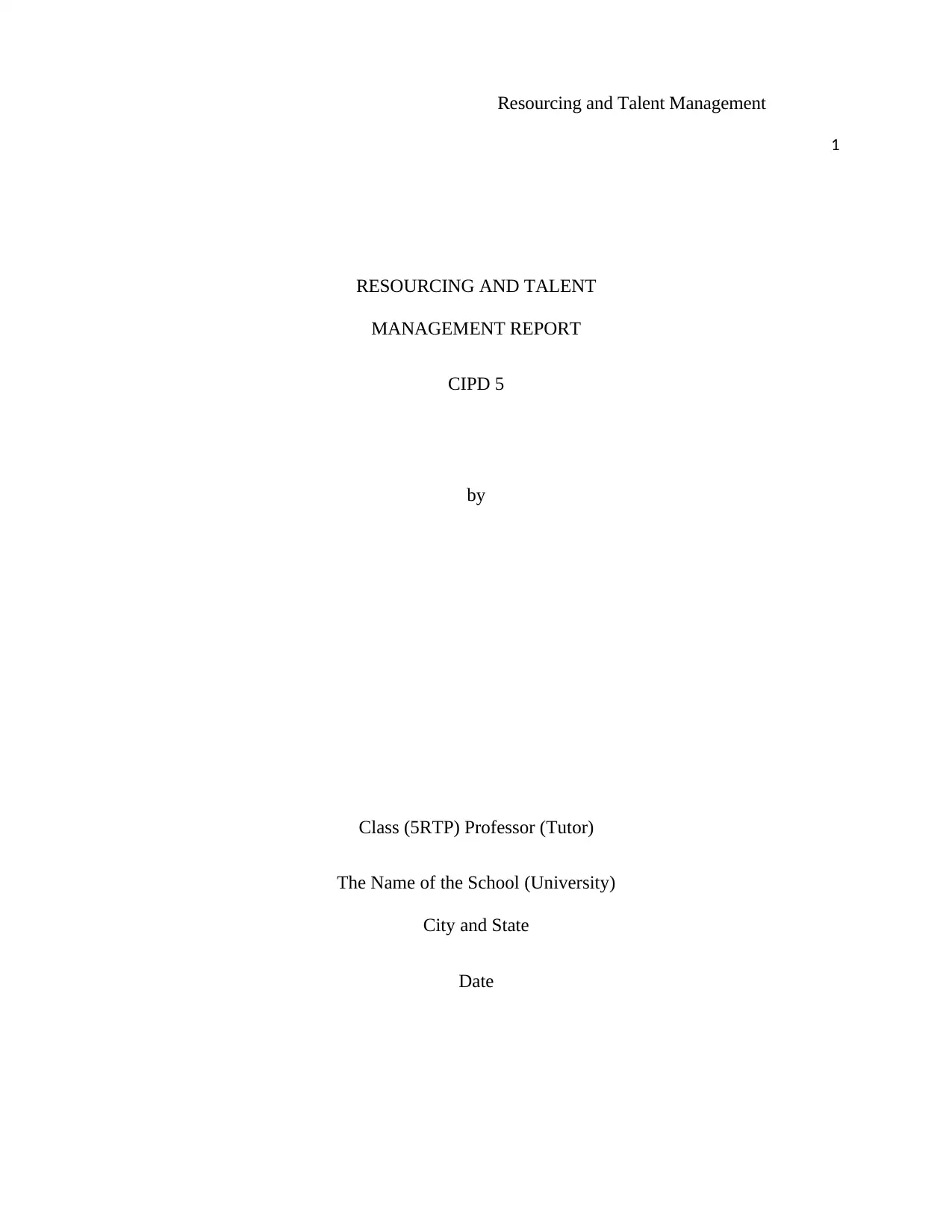
Resourcing and Talent Management
1
RESOURCING AND TALENT
MANAGEMENT REPORT
CIPD 5
by
Class (5RTP) Professor (Tutor)
The Name of the School (University)
City and State
Date
1
RESOURCING AND TALENT
MANAGEMENT REPORT
CIPD 5
by
Class (5RTP) Professor (Tutor)
The Name of the School (University)
City and State
Date
Paraphrase This Document
Need a fresh take? Get an instant paraphrase of this document with our AI Paraphraser
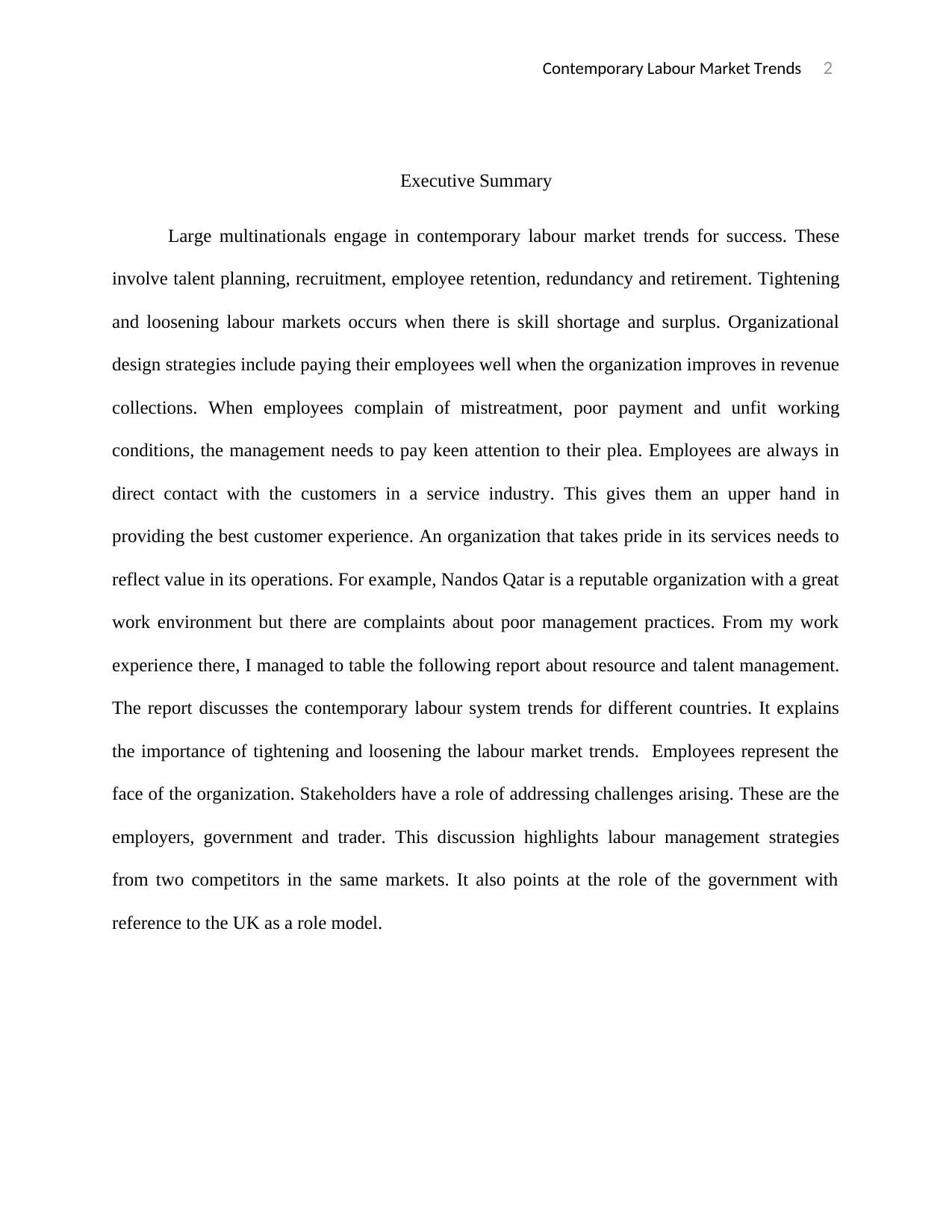
Contemporary Labour Market Trends 2
Executive Summary
Large multinationals engage in contemporary labour market trends for success. These
involve talent planning, recruitment, employee retention, redundancy and retirement. Tightening
and loosening labour markets occurs when there is skill shortage and surplus. Organizational
design strategies include paying their employees well when the organization improves in revenue
collections. When employees complain of mistreatment, poor payment and unfit working
conditions, the management needs to pay keen attention to their plea. Employees are always in
direct contact with the customers in a service industry. This gives them an upper hand in
providing the best customer experience. An organization that takes pride in its services needs to
reflect value in its operations. For example, Nandos Qatar is a reputable organization with a great
work environment but there are complaints about poor management practices. From my work
experience there, I managed to table the following report about resource and talent management.
The report discusses the contemporary labour system trends for different countries. It explains
the importance of tightening and loosening the labour market trends. Employees represent the
face of the organization. Stakeholders have a role of addressing challenges arising. These are the
employers, government and trader. This discussion highlights labour management strategies
from two competitors in the same markets. It also points at the role of the government with
reference to the UK as a role model.
Executive Summary
Large multinationals engage in contemporary labour market trends for success. These
involve talent planning, recruitment, employee retention, redundancy and retirement. Tightening
and loosening labour markets occurs when there is skill shortage and surplus. Organizational
design strategies include paying their employees well when the organization improves in revenue
collections. When employees complain of mistreatment, poor payment and unfit working
conditions, the management needs to pay keen attention to their plea. Employees are always in
direct contact with the customers in a service industry. This gives them an upper hand in
providing the best customer experience. An organization that takes pride in its services needs to
reflect value in its operations. For example, Nandos Qatar is a reputable organization with a great
work environment but there are complaints about poor management practices. From my work
experience there, I managed to table the following report about resource and talent management.
The report discusses the contemporary labour system trends for different countries. It explains
the importance of tightening and loosening the labour market trends. Employees represent the
face of the organization. Stakeholders have a role of addressing challenges arising. These are the
employers, government and trader. This discussion highlights labour management strategies
from two competitors in the same markets. It also points at the role of the government with
reference to the UK as a role model.
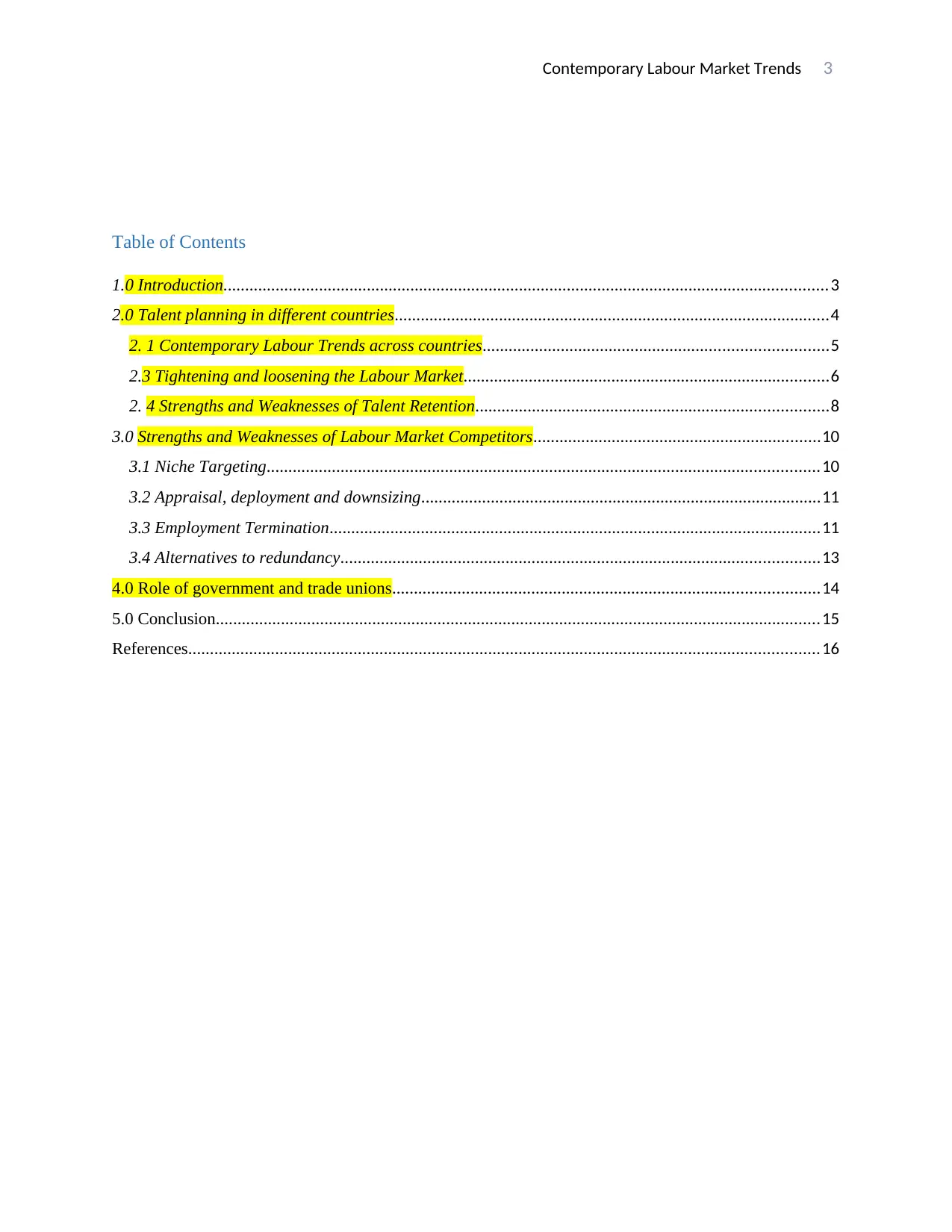
Contemporary Labour Market Trends 3
Table of Contents
1.0 Introduction...........................................................................................................................................3
2.0 Talent planning in different countries....................................................................................................4
2. 1 Contemporary Labour Trends across countries...............................................................................5
2.3 Tightening and loosening the Labour Market....................................................................................6
2. 4 Strengths and Weaknesses of Talent Retention.................................................................................8
3.0 Strengths and Weaknesses of Labour Market Competitors..................................................................10
3.1 Niche Targeting...............................................................................................................................10
3.2 Appraisal, deployment and downsizing............................................................................................11
3.3 Employment Termination.................................................................................................................11
3.4 Alternatives to redundancy..............................................................................................................13
4.0 Role of government and trade unions..................................................................................................14
5.0 Conclusion...........................................................................................................................................15
References.................................................................................................................................................16
Table of Contents
1.0 Introduction...........................................................................................................................................3
2.0 Talent planning in different countries....................................................................................................4
2. 1 Contemporary Labour Trends across countries...............................................................................5
2.3 Tightening and loosening the Labour Market....................................................................................6
2. 4 Strengths and Weaknesses of Talent Retention.................................................................................8
3.0 Strengths and Weaknesses of Labour Market Competitors..................................................................10
3.1 Niche Targeting...............................................................................................................................10
3.2 Appraisal, deployment and downsizing............................................................................................11
3.3 Employment Termination.................................................................................................................11
3.4 Alternatives to redundancy..............................................................................................................13
4.0 Role of government and trade unions..................................................................................................14
5.0 Conclusion...........................................................................................................................................15
References.................................................................................................................................................16
⊘ This is a preview!⊘
Do you want full access?
Subscribe today to unlock all pages.

Trusted by 1+ million students worldwide
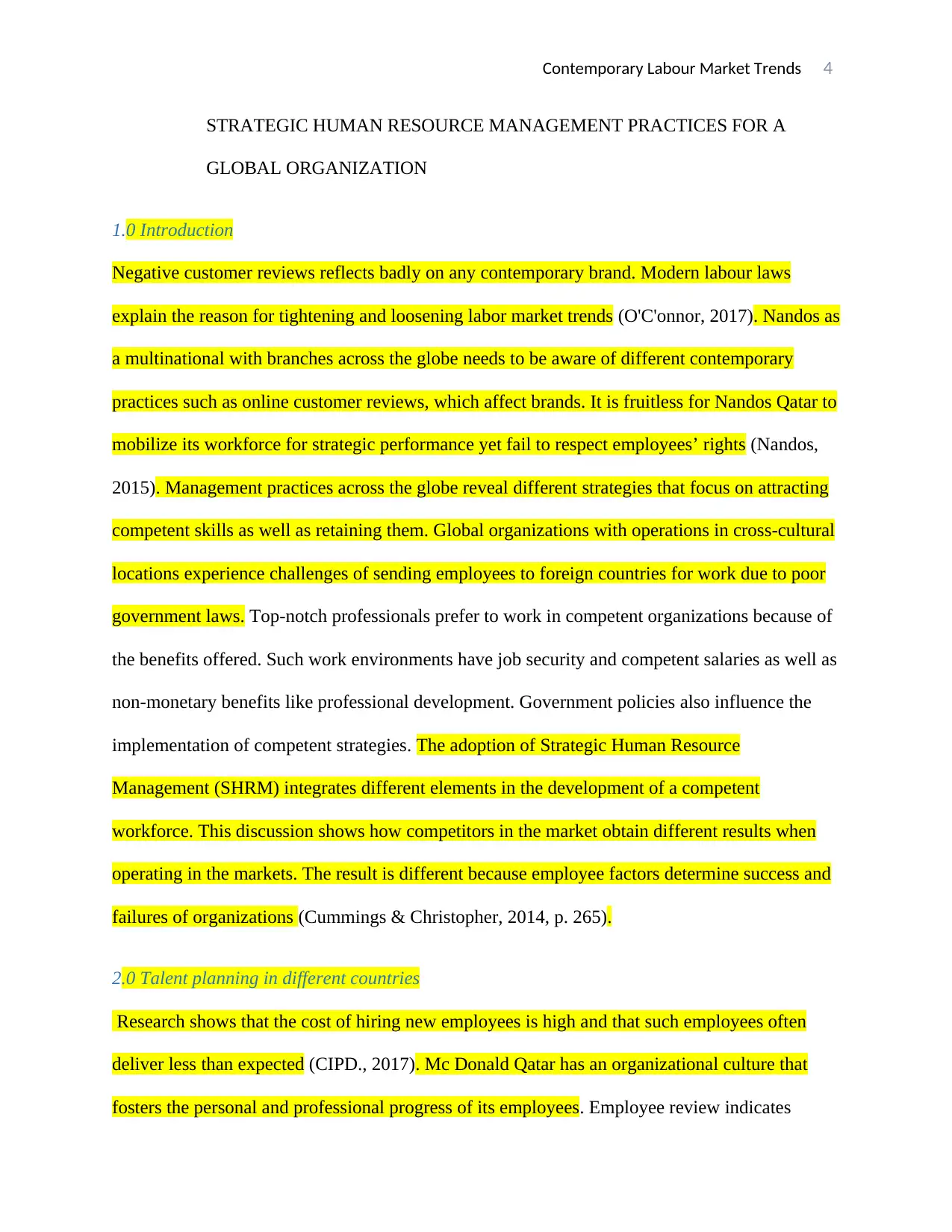
Contemporary Labour Market Trends 4
STRATEGIC HUMAN RESOURCE MANAGEMENT PRACTICES FOR A
GLOBAL ORGANIZATION
1.0 Introduction
Negative customer reviews reflects badly on any contemporary brand. Modern labour laws
explain the reason for tightening and loosening labor market trends (O'C'onnor, 2017). Nandos as
a multinational with branches across the globe needs to be aware of different contemporary
practices such as online customer reviews, which affect brands. It is fruitless for Nandos Qatar to
mobilize its workforce for strategic performance yet fail to respect employees’ rights (Nandos,
2015). Management practices across the globe reveal different strategies that focus on attracting
competent skills as well as retaining them. Global organizations with operations in cross-cultural
locations experience challenges of sending employees to foreign countries for work due to poor
government laws. Top-notch professionals prefer to work in competent organizations because of
the benefits offered. Such work environments have job security and competent salaries as well as
non-monetary benefits like professional development. Government policies also influence the
implementation of competent strategies. The adoption of Strategic Human Resource
Management (SHRM) integrates different elements in the development of a competent
workforce. This discussion shows how competitors in the market obtain different results when
operating in the markets. The result is different because employee factors determine success and
failures of organizations (Cummings & Christopher, 2014, p. 265).
2.0 Talent planning in different countries
Research shows that the cost of hiring new employees is high and that such employees often
deliver less than expected (CIPD., 2017). Mc Donald Qatar has an organizational culture that
fosters the personal and professional progress of its employees. Employee review indicates
STRATEGIC HUMAN RESOURCE MANAGEMENT PRACTICES FOR A
GLOBAL ORGANIZATION
1.0 Introduction
Negative customer reviews reflects badly on any contemporary brand. Modern labour laws
explain the reason for tightening and loosening labor market trends (O'C'onnor, 2017). Nandos as
a multinational with branches across the globe needs to be aware of different contemporary
practices such as online customer reviews, which affect brands. It is fruitless for Nandos Qatar to
mobilize its workforce for strategic performance yet fail to respect employees’ rights (Nandos,
2015). Management practices across the globe reveal different strategies that focus on attracting
competent skills as well as retaining them. Global organizations with operations in cross-cultural
locations experience challenges of sending employees to foreign countries for work due to poor
government laws. Top-notch professionals prefer to work in competent organizations because of
the benefits offered. Such work environments have job security and competent salaries as well as
non-monetary benefits like professional development. Government policies also influence the
implementation of competent strategies. The adoption of Strategic Human Resource
Management (SHRM) integrates different elements in the development of a competent
workforce. This discussion shows how competitors in the market obtain different results when
operating in the markets. The result is different because employee factors determine success and
failures of organizations (Cummings & Christopher, 2014, p. 265).
2.0 Talent planning in different countries
Research shows that the cost of hiring new employees is high and that such employees often
deliver less than expected (CIPD., 2017). Mc Donald Qatar has an organizational culture that
fosters the personal and professional progress of its employees. Employee review indicates
Paraphrase This Document
Need a fresh take? Get an instant paraphrase of this document with our AI Paraphraser
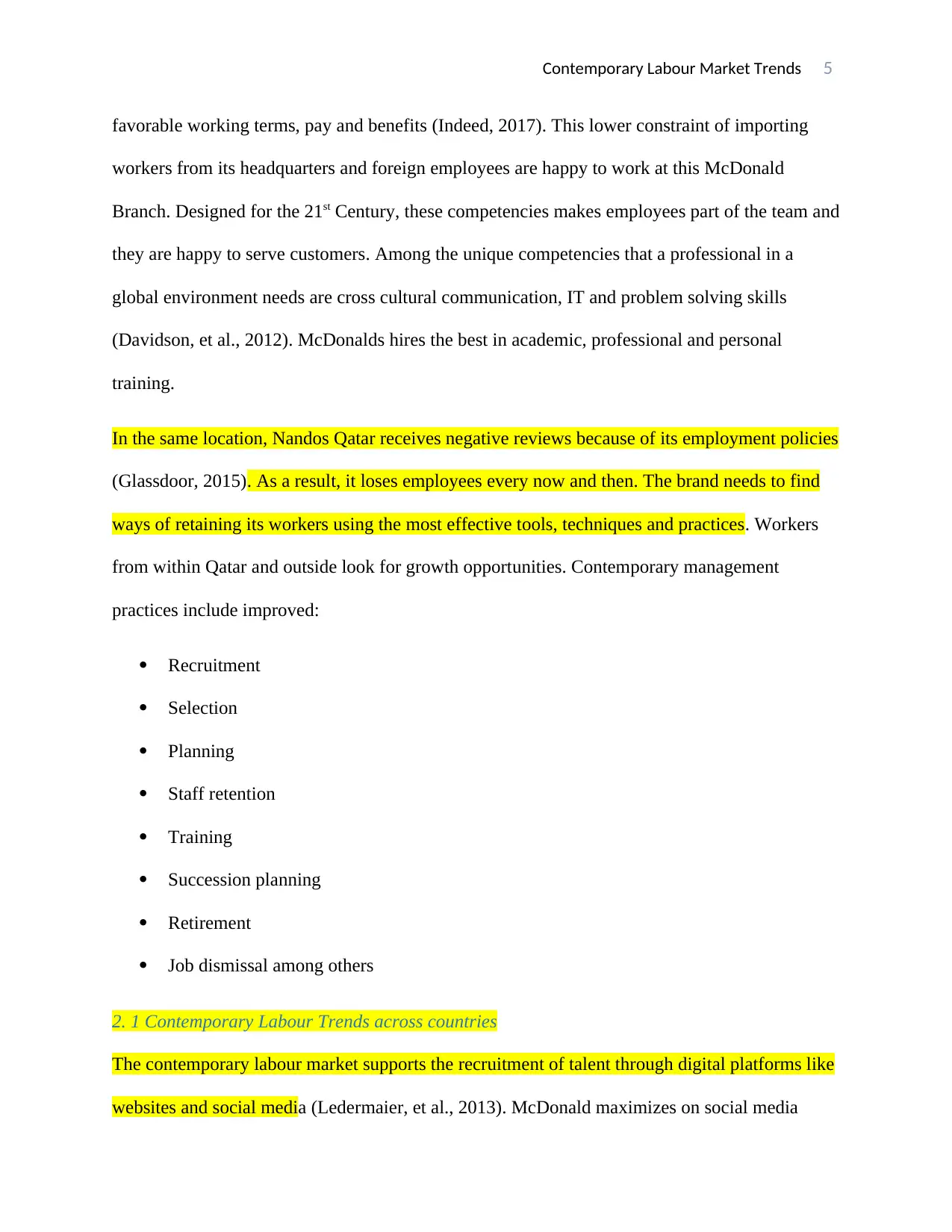
Contemporary Labour Market Trends 5
favorable working terms, pay and benefits (Indeed, 2017). This lower constraint of importing
workers from its headquarters and foreign employees are happy to work at this McDonald
Branch. Designed for the 21st Century, these competencies makes employees part of the team and
they are happy to serve customers. Among the unique competencies that a professional in a
global environment needs are cross cultural communication, IT and problem solving skills
(Davidson, et al., 2012). McDonalds hires the best in academic, professional and personal
training.
In the same location, Nandos Qatar receives negative reviews because of its employment policies
(Glassdoor, 2015). As a result, it loses employees every now and then. The brand needs to find
ways of retaining its workers using the most effective tools, techniques and practices. Workers
from within Qatar and outside look for growth opportunities. Contemporary management
practices include improved:
Recruitment
Selection
Planning
Staff retention
Training
Succession planning
Retirement
Job dismissal among others
2. 1 Contemporary Labour Trends across countries
The contemporary labour market supports the recruitment of talent through digital platforms like
websites and social media (Ledermaier, et al., 2013). McDonald maximizes on social media
favorable working terms, pay and benefits (Indeed, 2017). This lower constraint of importing
workers from its headquarters and foreign employees are happy to work at this McDonald
Branch. Designed for the 21st Century, these competencies makes employees part of the team and
they are happy to serve customers. Among the unique competencies that a professional in a
global environment needs are cross cultural communication, IT and problem solving skills
(Davidson, et al., 2012). McDonalds hires the best in academic, professional and personal
training.
In the same location, Nandos Qatar receives negative reviews because of its employment policies
(Glassdoor, 2015). As a result, it loses employees every now and then. The brand needs to find
ways of retaining its workers using the most effective tools, techniques and practices. Workers
from within Qatar and outside look for growth opportunities. Contemporary management
practices include improved:
Recruitment
Selection
Planning
Staff retention
Training
Succession planning
Retirement
Job dismissal among others
2. 1 Contemporary Labour Trends across countries
The contemporary labour market supports the recruitment of talent through digital platforms like
websites and social media (Ledermaier, et al., 2013). McDonald maximizes on social media
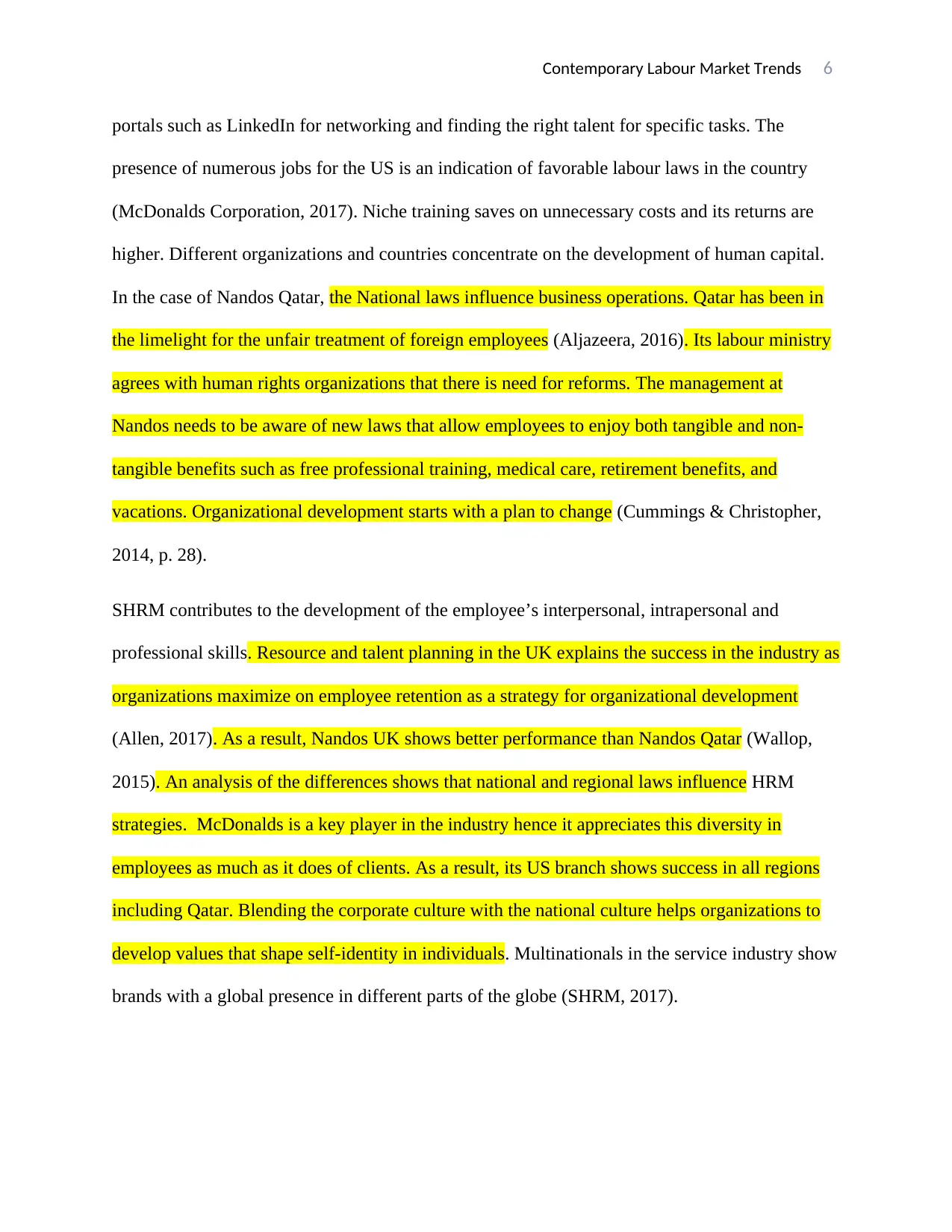
Contemporary Labour Market Trends 6
portals such as LinkedIn for networking and finding the right talent for specific tasks. The
presence of numerous jobs for the US is an indication of favorable labour laws in the country
(McDonalds Corporation, 2017). Niche training saves on unnecessary costs and its returns are
higher. Different organizations and countries concentrate on the development of human capital.
In the case of Nandos Qatar, the National laws influence business operations. Qatar has been in
the limelight for the unfair treatment of foreign employees (Aljazeera, 2016). Its labour ministry
agrees with human rights organizations that there is need for reforms. The management at
Nandos needs to be aware of new laws that allow employees to enjoy both tangible and non-
tangible benefits such as free professional training, medical care, retirement benefits, and
vacations. Organizational development starts with a plan to change (Cummings & Christopher,
2014, p. 28).
SHRM contributes to the development of the employee’s interpersonal, intrapersonal and
professional skills. Resource and talent planning in the UK explains the success in the industry as
organizations maximize on employee retention as a strategy for organizational development
(Allen, 2017). As a result, Nandos UK shows better performance than Nandos Qatar (Wallop,
2015). An analysis of the differences shows that national and regional laws influence HRM
strategies. McDonalds is a key player in the industry hence it appreciates this diversity in
employees as much as it does of clients. As a result, its US branch shows success in all regions
including Qatar. Blending the corporate culture with the national culture helps organizations to
develop values that shape self-identity in individuals. Multinationals in the service industry show
brands with a global presence in different parts of the globe (SHRM, 2017).
portals such as LinkedIn for networking and finding the right talent for specific tasks. The
presence of numerous jobs for the US is an indication of favorable labour laws in the country
(McDonalds Corporation, 2017). Niche training saves on unnecessary costs and its returns are
higher. Different organizations and countries concentrate on the development of human capital.
In the case of Nandos Qatar, the National laws influence business operations. Qatar has been in
the limelight for the unfair treatment of foreign employees (Aljazeera, 2016). Its labour ministry
agrees with human rights organizations that there is need for reforms. The management at
Nandos needs to be aware of new laws that allow employees to enjoy both tangible and non-
tangible benefits such as free professional training, medical care, retirement benefits, and
vacations. Organizational development starts with a plan to change (Cummings & Christopher,
2014, p. 28).
SHRM contributes to the development of the employee’s interpersonal, intrapersonal and
professional skills. Resource and talent planning in the UK explains the success in the industry as
organizations maximize on employee retention as a strategy for organizational development
(Allen, 2017). As a result, Nandos UK shows better performance than Nandos Qatar (Wallop,
2015). An analysis of the differences shows that national and regional laws influence HRM
strategies. McDonalds is a key player in the industry hence it appreciates this diversity in
employees as much as it does of clients. As a result, its US branch shows success in all regions
including Qatar. Blending the corporate culture with the national culture helps organizations to
develop values that shape self-identity in individuals. Multinationals in the service industry show
brands with a global presence in different parts of the globe (SHRM, 2017).
⊘ This is a preview!⊘
Do you want full access?
Subscribe today to unlock all pages.

Trusted by 1+ million students worldwide
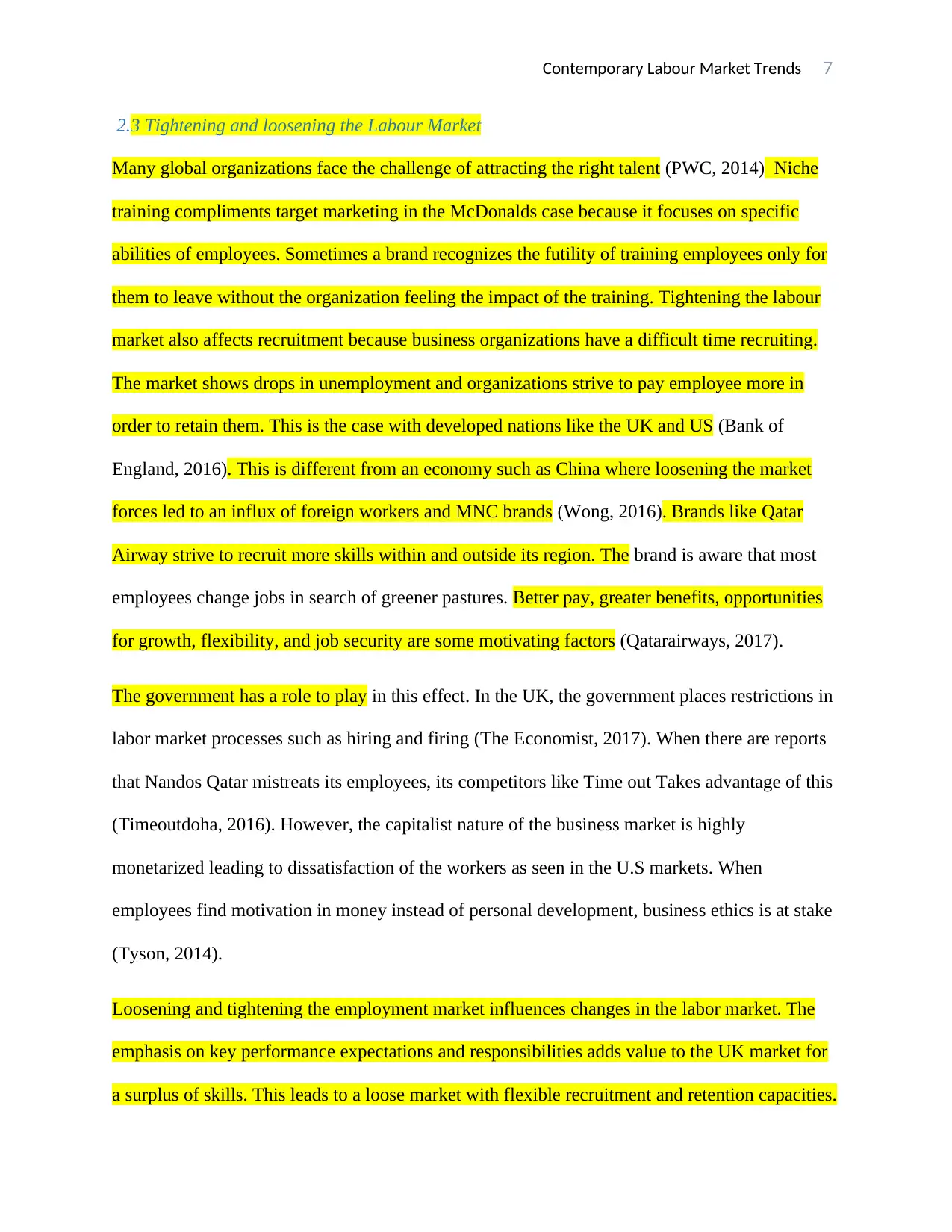
Contemporary Labour Market Trends 7
2.3 Tightening and loosening the Labour Market
Many global organizations face the challenge of attracting the right talent (PWC, 2014) Niche
training compliments target marketing in the McDonalds case because it focuses on specific
abilities of employees. Sometimes a brand recognizes the futility of training employees only for
them to leave without the organization feeling the impact of the training. Tightening the labour
market also affects recruitment because business organizations have a difficult time recruiting.
The market shows drops in unemployment and organizations strive to pay employee more in
order to retain them. This is the case with developed nations like the UK and US (Bank of
England, 2016). This is different from an economy such as China where loosening the market
forces led to an influx of foreign workers and MNC brands (Wong, 2016). Brands like Qatar
Airway strive to recruit more skills within and outside its region. The brand is aware that most
employees change jobs in search of greener pastures. Better pay, greater benefits, opportunities
for growth, flexibility, and job security are some motivating factors (Qatarairways, 2017).
The government has a role to play in this effect. In the UK, the government places restrictions in
labor market processes such as hiring and firing (The Economist, 2017). When there are reports
that Nandos Qatar mistreats its employees, its competitors like Time out Takes advantage of this
(Timeoutdoha, 2016). However, the capitalist nature of the business market is highly
monetarized leading to dissatisfaction of the workers as seen in the U.S markets. When
employees find motivation in money instead of personal development, business ethics is at stake
(Tyson, 2014).
Loosening and tightening the employment market influences changes in the labor market. The
emphasis on key performance expectations and responsibilities adds value to the UK market for
a surplus of skills. This leads to a loose market with flexible recruitment and retention capacities.
2.3 Tightening and loosening the Labour Market
Many global organizations face the challenge of attracting the right talent (PWC, 2014) Niche
training compliments target marketing in the McDonalds case because it focuses on specific
abilities of employees. Sometimes a brand recognizes the futility of training employees only for
them to leave without the organization feeling the impact of the training. Tightening the labour
market also affects recruitment because business organizations have a difficult time recruiting.
The market shows drops in unemployment and organizations strive to pay employee more in
order to retain them. This is the case with developed nations like the UK and US (Bank of
England, 2016). This is different from an economy such as China where loosening the market
forces led to an influx of foreign workers and MNC brands (Wong, 2016). Brands like Qatar
Airway strive to recruit more skills within and outside its region. The brand is aware that most
employees change jobs in search of greener pastures. Better pay, greater benefits, opportunities
for growth, flexibility, and job security are some motivating factors (Qatarairways, 2017).
The government has a role to play in this effect. In the UK, the government places restrictions in
labor market processes such as hiring and firing (The Economist, 2017). When there are reports
that Nandos Qatar mistreats its employees, its competitors like Time out Takes advantage of this
(Timeoutdoha, 2016). However, the capitalist nature of the business market is highly
monetarized leading to dissatisfaction of the workers as seen in the U.S markets. When
employees find motivation in money instead of personal development, business ethics is at stake
(Tyson, 2014).
Loosening and tightening the employment market influences changes in the labor market. The
emphasis on key performance expectations and responsibilities adds value to the UK market for
a surplus of skills. This leads to a loose market with flexible recruitment and retention capacities.
Paraphrase This Document
Need a fresh take? Get an instant paraphrase of this document with our AI Paraphraser
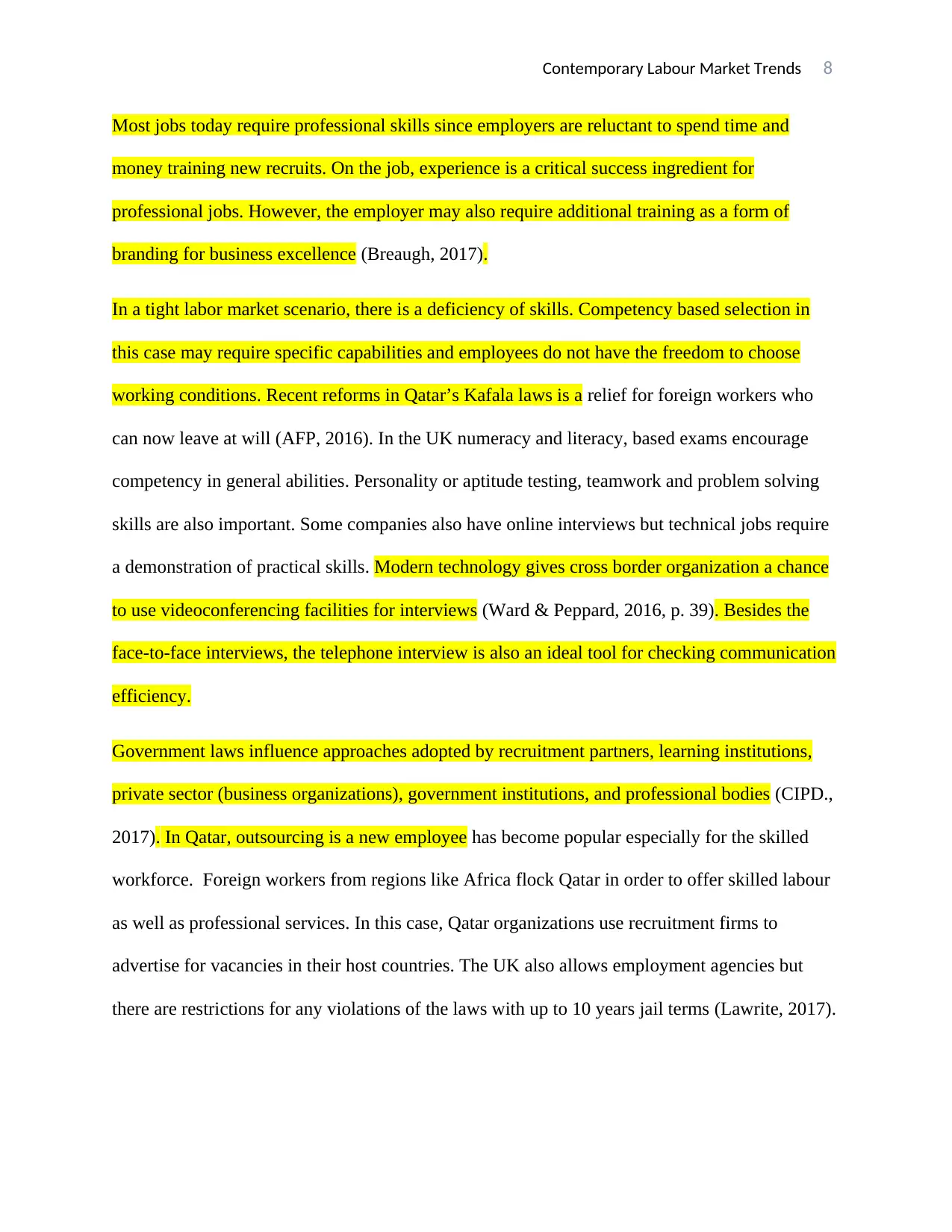
Contemporary Labour Market Trends 8
Most jobs today require professional skills since employers are reluctant to spend time and
money training new recruits. On the job, experience is a critical success ingredient for
professional jobs. However, the employer may also require additional training as a form of
branding for business excellence (Breaugh, 2017).
In a tight labor market scenario, there is a deficiency of skills. Competency based selection in
this case may require specific capabilities and employees do not have the freedom to choose
working conditions. Recent reforms in Qatar’s Kafala laws is a relief for foreign workers who
can now leave at will (AFP, 2016). In the UK numeracy and literacy, based exams encourage
competency in general abilities. Personality or aptitude testing, teamwork and problem solving
skills are also important. Some companies also have online interviews but technical jobs require
a demonstration of practical skills. Modern technology gives cross border organization a chance
to use videoconferencing facilities for interviews (Ward & Peppard, 2016, p. 39). Besides the
face-to-face interviews, the telephone interview is also an ideal tool for checking communication
efficiency.
Government laws influence approaches adopted by recruitment partners, learning institutions,
private sector (business organizations), government institutions, and professional bodies (CIPD.,
2017). In Qatar, outsourcing is a new employee has become popular especially for the skilled
workforce. Foreign workers from regions like Africa flock Qatar in order to offer skilled labour
as well as professional services. In this case, Qatar organizations use recruitment firms to
advertise for vacancies in their host countries. The UK also allows employment agencies but
there are restrictions for any violations of the laws with up to 10 years jail terms (Lawrite, 2017).
Most jobs today require professional skills since employers are reluctant to spend time and
money training new recruits. On the job, experience is a critical success ingredient for
professional jobs. However, the employer may also require additional training as a form of
branding for business excellence (Breaugh, 2017).
In a tight labor market scenario, there is a deficiency of skills. Competency based selection in
this case may require specific capabilities and employees do not have the freedom to choose
working conditions. Recent reforms in Qatar’s Kafala laws is a relief for foreign workers who
can now leave at will (AFP, 2016). In the UK numeracy and literacy, based exams encourage
competency in general abilities. Personality or aptitude testing, teamwork and problem solving
skills are also important. Some companies also have online interviews but technical jobs require
a demonstration of practical skills. Modern technology gives cross border organization a chance
to use videoconferencing facilities for interviews (Ward & Peppard, 2016, p. 39). Besides the
face-to-face interviews, the telephone interview is also an ideal tool for checking communication
efficiency.
Government laws influence approaches adopted by recruitment partners, learning institutions,
private sector (business organizations), government institutions, and professional bodies (CIPD.,
2017). In Qatar, outsourcing is a new employee has become popular especially for the skilled
workforce. Foreign workers from regions like Africa flock Qatar in order to offer skilled labour
as well as professional services. In this case, Qatar organizations use recruitment firms to
advertise for vacancies in their host countries. The UK also allows employment agencies but
there are restrictions for any violations of the laws with up to 10 years jail terms (Lawrite, 2017).
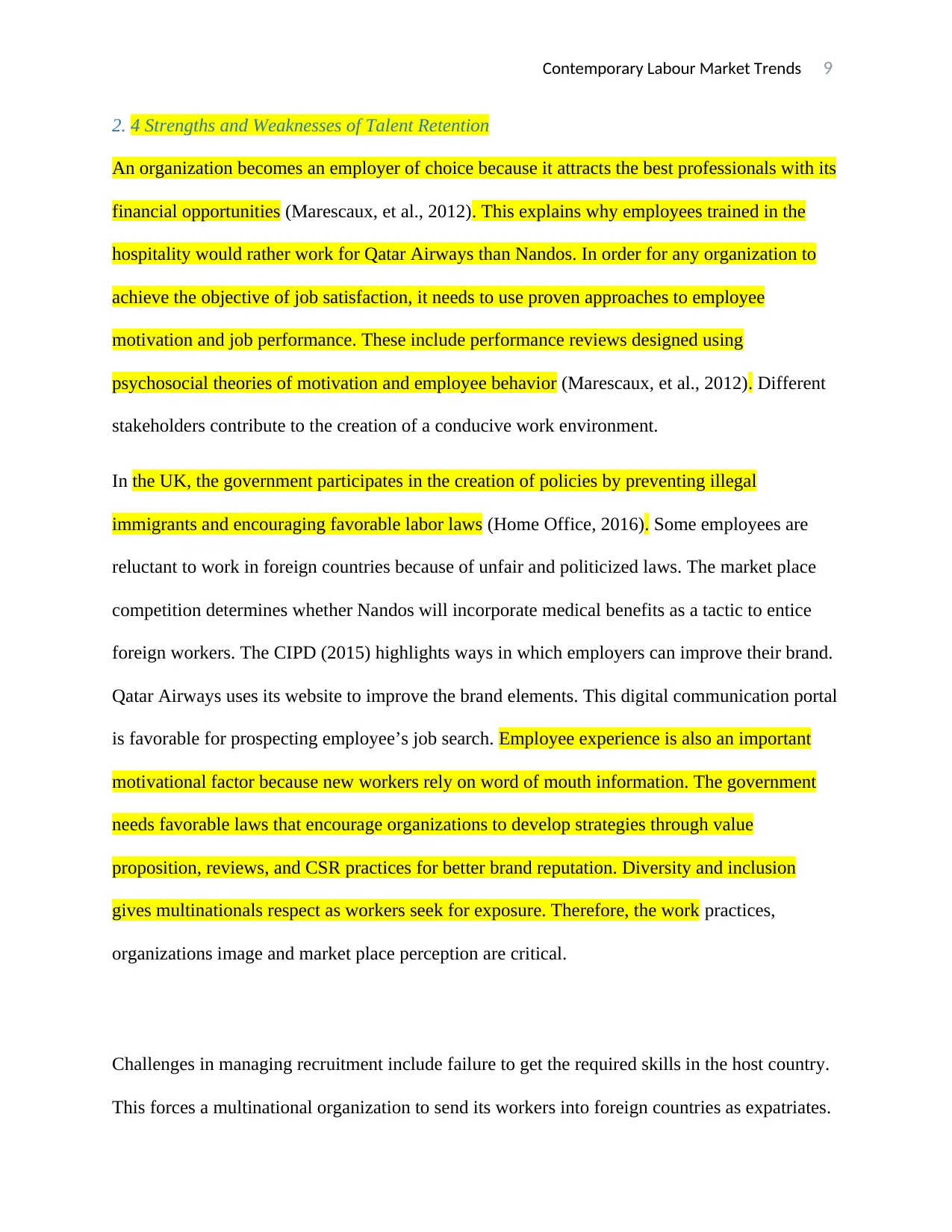
Contemporary Labour Market Trends 9
2. 4 Strengths and Weaknesses of Talent Retention
An organization becomes an employer of choice because it attracts the best professionals with its
financial opportunities (Marescaux, et al., 2012). This explains why employees trained in the
hospitality would rather work for Qatar Airways than Nandos. In order for any organization to
achieve the objective of job satisfaction, it needs to use proven approaches to employee
motivation and job performance. These include performance reviews designed using
psychosocial theories of motivation and employee behavior (Marescaux, et al., 2012). Different
stakeholders contribute to the creation of a conducive work environment.
In the UK, the government participates in the creation of policies by preventing illegal
immigrants and encouraging favorable labor laws (Home Office, 2016). Some employees are
reluctant to work in foreign countries because of unfair and politicized laws. The market place
competition determines whether Nandos will incorporate medical benefits as a tactic to entice
foreign workers. The CIPD (2015) highlights ways in which employers can improve their brand.
Qatar Airways uses its website to improve the brand elements. This digital communication portal
is favorable for prospecting employee’s job search. Employee experience is also an important
motivational factor because new workers rely on word of mouth information. The government
needs favorable laws that encourage organizations to develop strategies through value
proposition, reviews, and CSR practices for better brand reputation. Diversity and inclusion
gives multinationals respect as workers seek for exposure. Therefore, the work practices,
organizations image and market place perception are critical.
Challenges in managing recruitment include failure to get the required skills in the host country.
This forces a multinational organization to send its workers into foreign countries as expatriates.
2. 4 Strengths and Weaknesses of Talent Retention
An organization becomes an employer of choice because it attracts the best professionals with its
financial opportunities (Marescaux, et al., 2012). This explains why employees trained in the
hospitality would rather work for Qatar Airways than Nandos. In order for any organization to
achieve the objective of job satisfaction, it needs to use proven approaches to employee
motivation and job performance. These include performance reviews designed using
psychosocial theories of motivation and employee behavior (Marescaux, et al., 2012). Different
stakeholders contribute to the creation of a conducive work environment.
In the UK, the government participates in the creation of policies by preventing illegal
immigrants and encouraging favorable labor laws (Home Office, 2016). Some employees are
reluctant to work in foreign countries because of unfair and politicized laws. The market place
competition determines whether Nandos will incorporate medical benefits as a tactic to entice
foreign workers. The CIPD (2015) highlights ways in which employers can improve their brand.
Qatar Airways uses its website to improve the brand elements. This digital communication portal
is favorable for prospecting employee’s job search. Employee experience is also an important
motivational factor because new workers rely on word of mouth information. The government
needs favorable laws that encourage organizations to develop strategies through value
proposition, reviews, and CSR practices for better brand reputation. Diversity and inclusion
gives multinationals respect as workers seek for exposure. Therefore, the work practices,
organizations image and market place perception are critical.
Challenges in managing recruitment include failure to get the required skills in the host country.
This forces a multinational organization to send its workers into foreign countries as expatriates.
⊘ This is a preview!⊘
Do you want full access?
Subscribe today to unlock all pages.

Trusted by 1+ million students worldwide
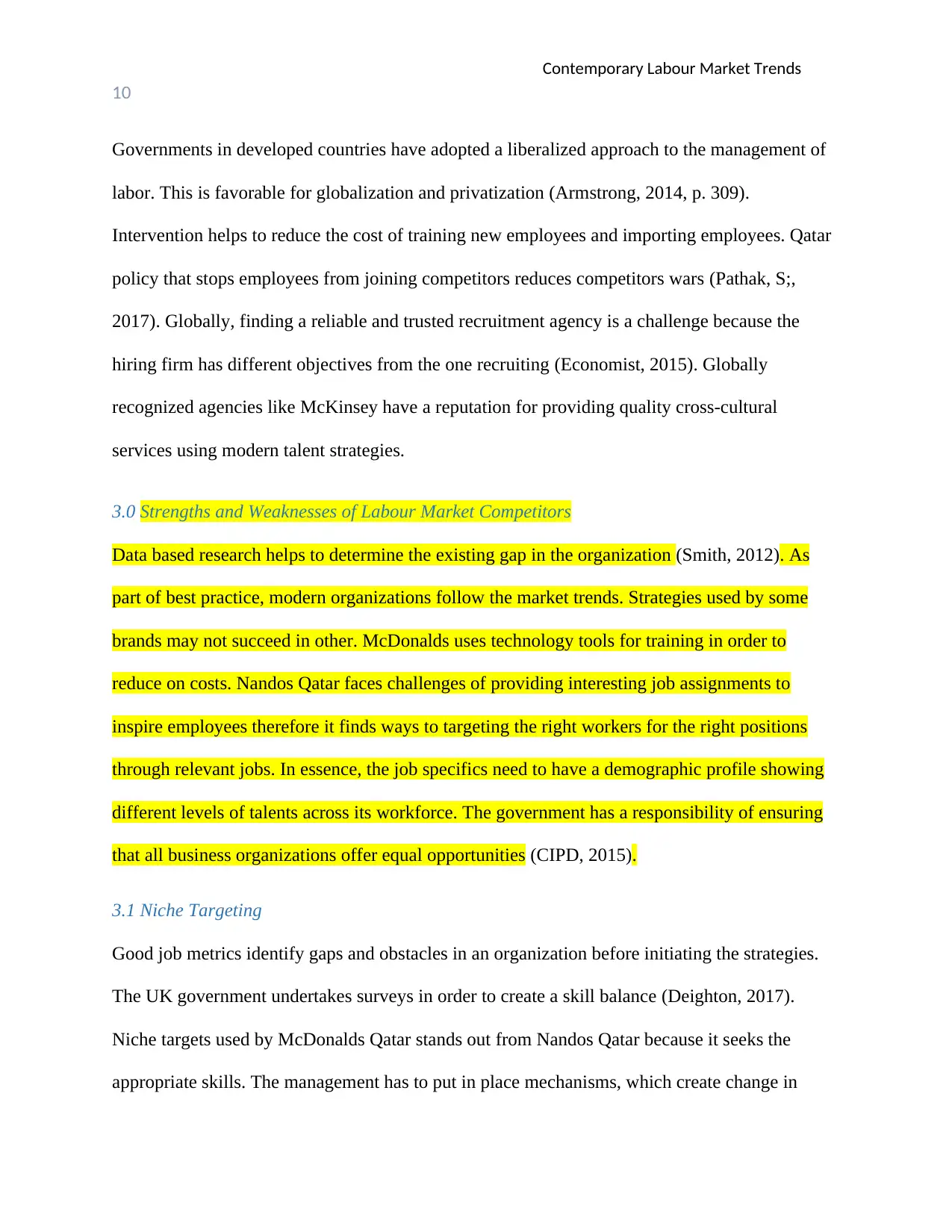
Contemporary Labour Market Trends
10
Governments in developed countries have adopted a liberalized approach to the management of
labor. This is favorable for globalization and privatization (Armstrong, 2014, p. 309).
Intervention helps to reduce the cost of training new employees and importing employees. Qatar
policy that stops employees from joining competitors reduces competitors wars (Pathak, S;,
2017). Globally, finding a reliable and trusted recruitment agency is a challenge because the
hiring firm has different objectives from the one recruiting (Economist, 2015). Globally
recognized agencies like McKinsey have a reputation for providing quality cross-cultural
services using modern talent strategies.
3.0 Strengths and Weaknesses of Labour Market Competitors
Data based research helps to determine the existing gap in the organization (Smith, 2012). As
part of best practice, modern organizations follow the market trends. Strategies used by some
brands may not succeed in other. McDonalds uses technology tools for training in order to
reduce on costs. Nandos Qatar faces challenges of providing interesting job assignments to
inspire employees therefore it finds ways to targeting the right workers for the right positions
through relevant jobs. In essence, the job specifics need to have a demographic profile showing
different levels of talents across its workforce. The government has a responsibility of ensuring
that all business organizations offer equal opportunities (CIPD, 2015).
3.1 Niche Targeting
Good job metrics identify gaps and obstacles in an organization before initiating the strategies.
The UK government undertakes surveys in order to create a skill balance (Deighton, 2017).
Niche targets used by McDonalds Qatar stands out from Nandos Qatar because it seeks the
appropriate skills. The management has to put in place mechanisms, which create change in
10
Governments in developed countries have adopted a liberalized approach to the management of
labor. This is favorable for globalization and privatization (Armstrong, 2014, p. 309).
Intervention helps to reduce the cost of training new employees and importing employees. Qatar
policy that stops employees from joining competitors reduces competitors wars (Pathak, S;,
2017). Globally, finding a reliable and trusted recruitment agency is a challenge because the
hiring firm has different objectives from the one recruiting (Economist, 2015). Globally
recognized agencies like McKinsey have a reputation for providing quality cross-cultural
services using modern talent strategies.
3.0 Strengths and Weaknesses of Labour Market Competitors
Data based research helps to determine the existing gap in the organization (Smith, 2012). As
part of best practice, modern organizations follow the market trends. Strategies used by some
brands may not succeed in other. McDonalds uses technology tools for training in order to
reduce on costs. Nandos Qatar faces challenges of providing interesting job assignments to
inspire employees therefore it finds ways to targeting the right workers for the right positions
through relevant jobs. In essence, the job specifics need to have a demographic profile showing
different levels of talents across its workforce. The government has a responsibility of ensuring
that all business organizations offer equal opportunities (CIPD, 2015).
3.1 Niche Targeting
Good job metrics identify gaps and obstacles in an organization before initiating the strategies.
The UK government undertakes surveys in order to create a skill balance (Deighton, 2017).
Niche targets used by McDonalds Qatar stands out from Nandos Qatar because it seeks the
appropriate skills. The management has to put in place mechanisms, which create change in
Paraphrase This Document
Need a fresh take? Get an instant paraphrase of this document with our AI Paraphraser
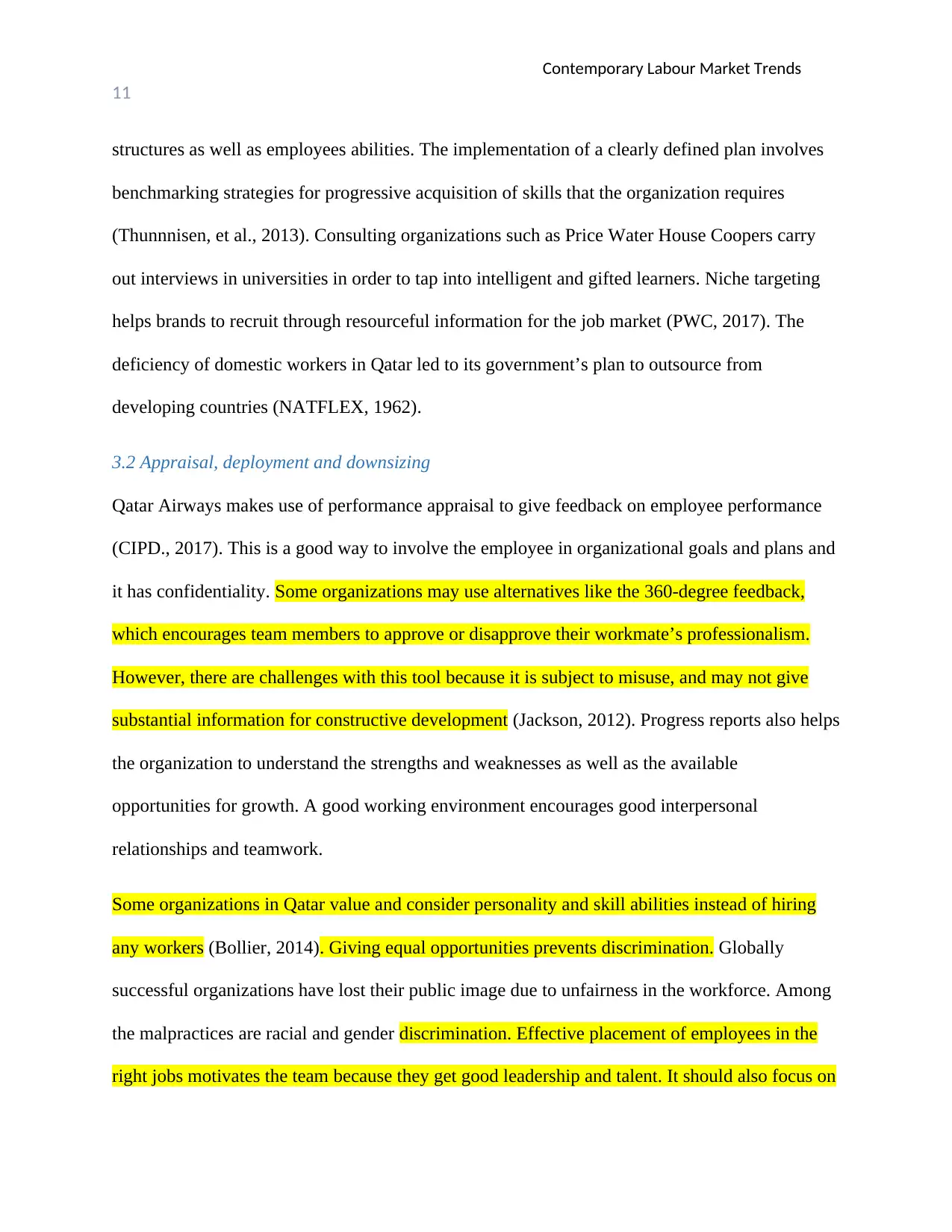
Contemporary Labour Market Trends
11
structures as well as employees abilities. The implementation of a clearly defined plan involves
benchmarking strategies for progressive acquisition of skills that the organization requires
(Thunnnisen, et al., 2013). Consulting organizations such as Price Water House Coopers carry
out interviews in universities in order to tap into intelligent and gifted learners. Niche targeting
helps brands to recruit through resourceful information for the job market (PWC, 2017). The
deficiency of domestic workers in Qatar led to its government’s plan to outsource from
developing countries (NATFLEX, 1962).
3.2 Appraisal, deployment and downsizing
Qatar Airways makes use of performance appraisal to give feedback on employee performance
(CIPD., 2017). This is a good way to involve the employee in organizational goals and plans and
it has confidentiality. Some organizations may use alternatives like the 360-degree feedback,
which encourages team members to approve or disapprove their workmate’s professionalism.
However, there are challenges with this tool because it is subject to misuse, and may not give
substantial information for constructive development (Jackson, 2012). Progress reports also helps
the organization to understand the strengths and weaknesses as well as the available
opportunities for growth. A good working environment encourages good interpersonal
relationships and teamwork.
Some organizations in Qatar value and consider personality and skill abilities instead of hiring
any workers (Bollier, 2014). Giving equal opportunities prevents discrimination. Globally
successful organizations have lost their public image due to unfairness in the workforce. Among
the malpractices are racial and gender discrimination. Effective placement of employees in the
right jobs motivates the team because they get good leadership and talent. It should also focus on
11
structures as well as employees abilities. The implementation of a clearly defined plan involves
benchmarking strategies for progressive acquisition of skills that the organization requires
(Thunnnisen, et al., 2013). Consulting organizations such as Price Water House Coopers carry
out interviews in universities in order to tap into intelligent and gifted learners. Niche targeting
helps brands to recruit through resourceful information for the job market (PWC, 2017). The
deficiency of domestic workers in Qatar led to its government’s plan to outsource from
developing countries (NATFLEX, 1962).
3.2 Appraisal, deployment and downsizing
Qatar Airways makes use of performance appraisal to give feedback on employee performance
(CIPD., 2017). This is a good way to involve the employee in organizational goals and plans and
it has confidentiality. Some organizations may use alternatives like the 360-degree feedback,
which encourages team members to approve or disapprove their workmate’s professionalism.
However, there are challenges with this tool because it is subject to misuse, and may not give
substantial information for constructive development (Jackson, 2012). Progress reports also helps
the organization to understand the strengths and weaknesses as well as the available
opportunities for growth. A good working environment encourages good interpersonal
relationships and teamwork.
Some organizations in Qatar value and consider personality and skill abilities instead of hiring
any workers (Bollier, 2014). Giving equal opportunities prevents discrimination. Globally
successful organizations have lost their public image due to unfairness in the workforce. Among
the malpractices are racial and gender discrimination. Effective placement of employees in the
right jobs motivates the team because they get good leadership and talent. It should also focus on
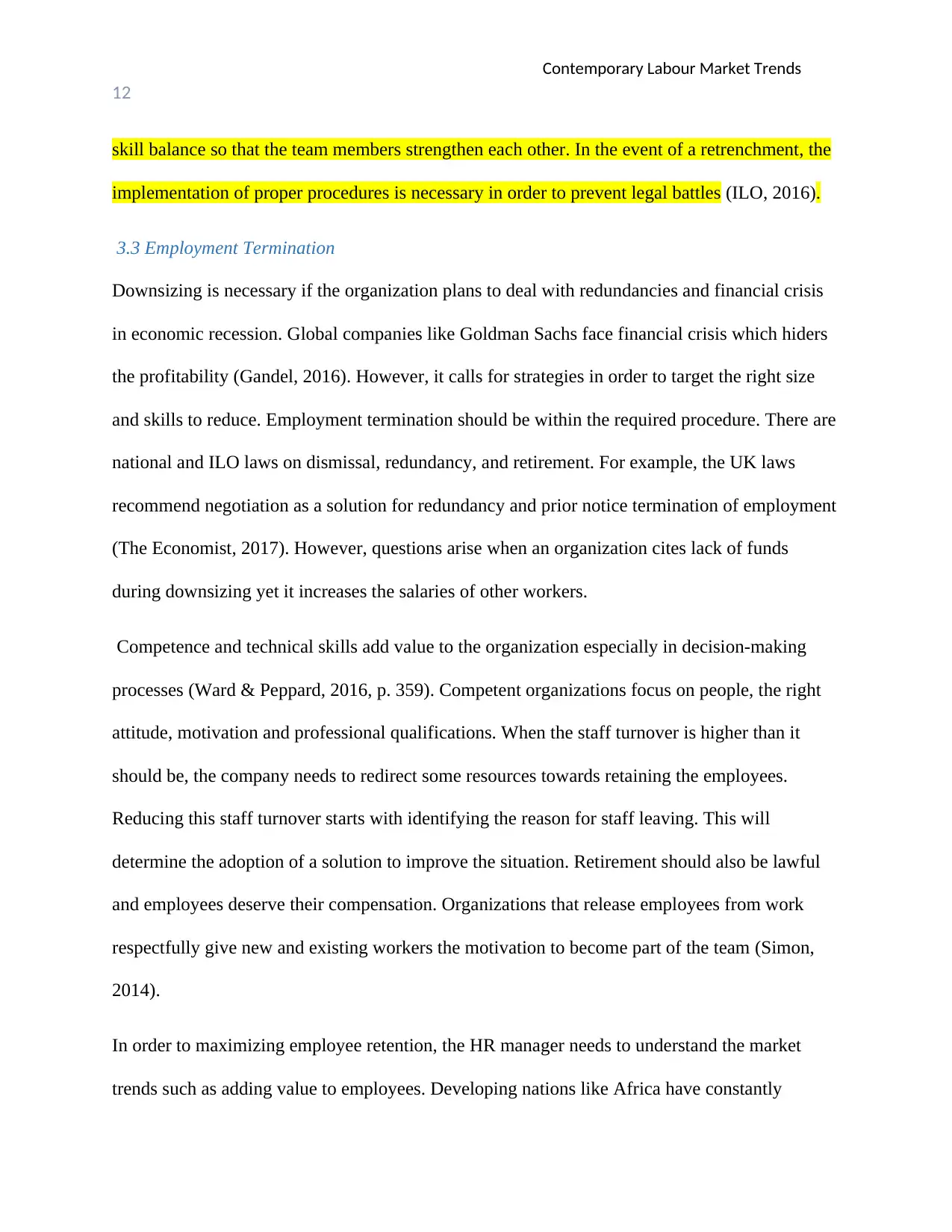
Contemporary Labour Market Trends
12
skill balance so that the team members strengthen each other. In the event of a retrenchment, the
implementation of proper procedures is necessary in order to prevent legal battles (ILO, 2016).
3.3 Employment Termination
Downsizing is necessary if the organization plans to deal with redundancies and financial crisis
in economic recession. Global companies like Goldman Sachs face financial crisis which hiders
the profitability (Gandel, 2016). However, it calls for strategies in order to target the right size
and skills to reduce. Employment termination should be within the required procedure. There are
national and ILO laws on dismissal, redundancy, and retirement. For example, the UK laws
recommend negotiation as a solution for redundancy and prior notice termination of employment
(The Economist, 2017). However, questions arise when an organization cites lack of funds
during downsizing yet it increases the salaries of other workers.
Competence and technical skills add value to the organization especially in decision-making
processes (Ward & Peppard, 2016, p. 359). Competent organizations focus on people, the right
attitude, motivation and professional qualifications. When the staff turnover is higher than it
should be, the company needs to redirect some resources towards retaining the employees.
Reducing this staff turnover starts with identifying the reason for staff leaving. This will
determine the adoption of a solution to improve the situation. Retirement should also be lawful
and employees deserve their compensation. Organizations that release employees from work
respectfully give new and existing workers the motivation to become part of the team (Simon,
2014).
In order to maximizing employee retention, the HR manager needs to understand the market
trends such as adding value to employees. Developing nations like Africa have constantly
12
skill balance so that the team members strengthen each other. In the event of a retrenchment, the
implementation of proper procedures is necessary in order to prevent legal battles (ILO, 2016).
3.3 Employment Termination
Downsizing is necessary if the organization plans to deal with redundancies and financial crisis
in economic recession. Global companies like Goldman Sachs face financial crisis which hiders
the profitability (Gandel, 2016). However, it calls for strategies in order to target the right size
and skills to reduce. Employment termination should be within the required procedure. There are
national and ILO laws on dismissal, redundancy, and retirement. For example, the UK laws
recommend negotiation as a solution for redundancy and prior notice termination of employment
(The Economist, 2017). However, questions arise when an organization cites lack of funds
during downsizing yet it increases the salaries of other workers.
Competence and technical skills add value to the organization especially in decision-making
processes (Ward & Peppard, 2016, p. 359). Competent organizations focus on people, the right
attitude, motivation and professional qualifications. When the staff turnover is higher than it
should be, the company needs to redirect some resources towards retaining the employees.
Reducing this staff turnover starts with identifying the reason for staff leaving. This will
determine the adoption of a solution to improve the situation. Retirement should also be lawful
and employees deserve their compensation. Organizations that release employees from work
respectfully give new and existing workers the motivation to become part of the team (Simon,
2014).
In order to maximizing employee retention, the HR manager needs to understand the market
trends such as adding value to employees. Developing nations like Africa have constantly
⊘ This is a preview!⊘
Do you want full access?
Subscribe today to unlock all pages.

Trusted by 1+ million students worldwide
1 out of 22
Related Documents
Your All-in-One AI-Powered Toolkit for Academic Success.
+13062052269
info@desklib.com
Available 24*7 on WhatsApp / Email
![[object Object]](/_next/static/media/star-bottom.7253800d.svg)
Unlock your academic potential
Copyright © 2020–2025 A2Z Services. All Rights Reserved. Developed and managed by ZUCOL.





